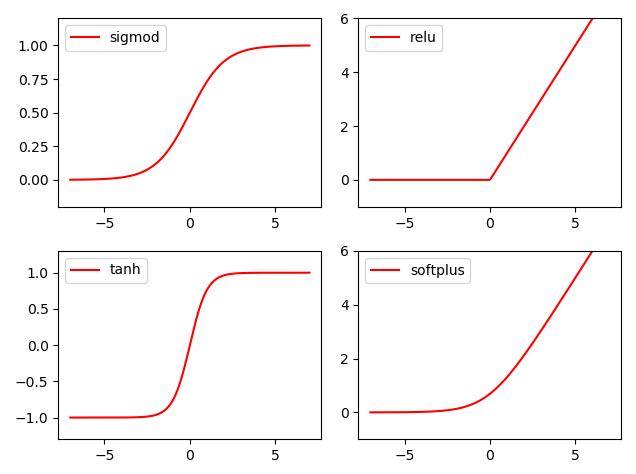#!/usr/bin/env python
# -*- coding:utf-8 -*-
# author:love_cat
import numpy as np
import matplotlib.pyplot as plt
import tensorflow as tf
# 输入数据
x = np.linspace(-7, 7, 180)
def sigmoid(inputs):
y = [1 / float(1 + np.exp(-t)) for t in inputs]
return y
def relu(inputs):
y = [t * (t > 0) for t in inputs]
return y
def tanh(inputs):
y = [(np.exp(t) - np.exp(-t)) / (np.exp(t) + np.exp(-t)) for t in inputs]
return y
def softplus(inputs):
y = [np.log(1 + np.exp(t)) for t in inputs]
return y
# 经过TensorFlow激活函数处理的每个y值
y_sigmoid = tf.nn.sigmoid(x)
y_relu = tf.nn.relu(x)
y_tanh = tf.nn.tanh(x)
y_softplus = tf.nn.softplus(x)
# 创建会话
sess = tf.Session()
# 运行
y_sigmoid, y_relu, y_tanh, y_softplus = sess.run([y_sigmoid, y_relu, y_tanh, y_softplus])
# 创建各个激活函数的图像
plt.subplot(221)
plt.plot(x, y_sigmoid, color='red', label='sigmod')
plt.ylim(-0.2, 1.2)
plt.legend(loc='best')
plt.subplot(222)
plt.plot(x, y_relu, color='red', label='relu')
plt.ylim(-1, 6)
plt.legend(loc='best')
plt.subplot(223)
plt.plot(x, y_tanh, color='red', label='tanh')
plt.ylim(-1.3, 1.3)
plt.legend(loc='best')
plt.subplot(224)
plt.plot(x, y_softplus, color='red', label='softplus')
plt.ylim(-1, 6)
plt.legend(loc='best')
# 显示图像
plt.show()
# 关闭会话
sess.close()
